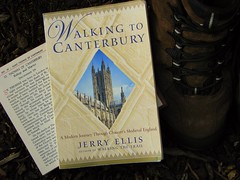I love walking. A good walk has the power to revive your body and spirit whether it’s in the woods, a park, along a waterfront, or just in the neighborhood. I try to slip one in whenever possible — if I’m not out biking, of course. That’s my favorite exercise.  Often, if my wife wants to go to a matinée, I’ll take an hour head start, cover the four miles to the theater on foot and meet her at the box office. (I’m not one to complain about bad parking spaces.) Longer walks are enjoyable, too, but I save that kind of energy for mountain hikes. Placing one foot in front of the other is somehow rejuvenating.
Often, if my wife wants to go to a matinée, I’ll take an hour head start, cover the four miles to the theater on foot and meet her at the box office. (I’m not one to complain about bad parking spaces.) Longer walks are enjoyable, too, but I save that kind of energy for mountain hikes. Placing one foot in front of the other is somehow rejuvenating.
Jerry Ellis’s walks are rejuvenating, but his treks pack more meaning than mine. Part Cherokee, Ellis was the first man to retrace the historic 900-mile “Trail of Tears” on foot. He wrote about it in Walking the Trail [LibraryThing / WorldCat]. Ellis is also part English, and it was that heritage that prompted the journey recounted in my latest read, Walking to Canterbury [LibraryThing / WorldCat].
Ellis held off reading Geoffrey Chaucer’s Canterbury Tales until his final semester in college, but his eventual study of that classic started him imagining what a modern Canterbury Tales might be like.
If you have no experience with the Tales — and you need none to enjoy this book — Chaucer tells the story of a group of people making the pilgrimage from London to the shrine of Sir Thomas Becket at Canterbury Cathedral. The pilgrims take turns telling stories during their week-long journey on foot. Their poignant and bawdy tales provide them entertainment. Those shared stories, as you may have guessed, are the tales mentioned in the title.
A lot has changed since the fourteenth century when Chaucer wrote his book. People don’t walk to Canterbury anymore. There are highways. But Canterbury Cathedral still stands 700 years later and Ellis was up for the walk in seven days. Walking to Canterbury is his tale of that journey.
Ellis interacts with all sorts of strangers along the way. He befriends teenagers who take him to their secret hideout. He chats with a few lonely hearts, revelers, and world-weary skeptics. He happens upon the consecration ceremony of a nun, visits an antique dealer, camps out under the stars, and carves figures on his walking stick.
People and events during his journey prompt Ellis to consider some stories from Chaucer’s book, life and death in the middle ages, and even the similarities of his own English-Cherokee heritage. Almost everything prompts an observation. The crucial story, of course, is that of Thomas Becket, the once-dear friend of King Henry II who was later murdered by the king’s men. The king’s remorse is legendary. I read Jean Anouilh’s play Becket last summer, coincidentally, because it was thin enough to take on a bike trip. The movie version with Richard Burton and Peter O’Toole is a classic in itself. I watched it shortly after reading the play.
I wouldn’t say Walking to Canterbury is a weighty, mind-blowing book that will change the way you see the world, but I will say that it was enjoyable. It moves along at an easy pace; appropriate for a walk. As Ellis hikes along Pilgrim’s Way, there’s time to notice life and consider how it has changed since Chaucer’s day.

